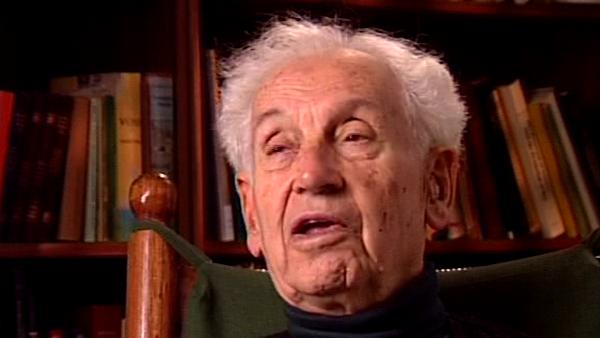NEXT STORY

Applying for American citizenship
RELATED STORIES

NEXT STORY

Applying for American citizenship
RELATED STORIES


|
Views | Duration | |
|---|---|---|---|
| 71. Founding the Evolutionary Society and establishing the journal | 1 | 218 | 04:08 |
| 72. Disagreement between geneticists and naturalists | 326 | 01:32 | |
| 73. The wrong Patterson | 166 | 01:48 | |
| 74. Fallout from the Patterson affair | 140 | 00:30 | |
| 75. A symposium on the evolutionary synthesis | 160 | 03:22 | |
| 76. Working with Earle Gorton Linsley | 155 | 03:42 | |
| 77. Reworking Principles of Systematic Zoology | 140 | 02:17 | |
| 78. Conflict between classification and cladification | 211 | 03:01 | |
| 79. Applying for American citizenship | 193 | 04:06 | |
| 80. Discriminated against for being German | 416 | 03:45 |


When Darwin wrote The Origin of Species he devoted a whole chapter – in the first edition it's chapter 13 – to classification. And he said that we normally arrange our grouping of species by similarity; we put the similar species together into a genus, and we put the similar genera together into a family and so on and so forth. However, he said… all these taxa that we thus recognize must… each of these taxa which we recognize must contain all the descendants of the nearest common ancestor, in other word, in addition to similarity, the criteria of genealogy, common descent. Well, in 1950 a German entomologist, Willi Hennig, published a book in which he said, ‘Let's forget about similarity and just put together things that are united by descent’. And so instead of recognizing classes of similar things he… his system – and that's why I call it cladification – consists of branches of the evolutionary tree, which leads to such curiosities we… that he finds that the mammals descended from one particular group of reptiles, and he follows that back to the very earliest ancestral species of that group of reptiles and then everything that descended from that species he puts into one of his clades, which brings together things that have no similarity whatsoever, some very primitive reptiles together with the hairy, warm-blooded, live-bearing, milk-producing, mammals. So, there is a very… now, if you're only interested in phylogeny, the Hennigian ordering system is quite useful, but if you want to classify… and you can look in any dictionary, it says a classification consists of groups of things that are similar and related, and Hennigian cladification does not consist of groups that are similar and related. His… his clades are… very often are highly heterogeneous and the earliest species in such a clade are totally different from the later ones in this same branch, so that it's just a totally different system and the… at the present time undoubtedly Hennig's thing is highly popular, particularly on people who are not basically taxonomists, but it certainly has nothing to do with a real classification in biology, and in any traditional sense, nothing to do with the way a classification should be as described by Darwin.
The late German-American biologist Ernst Mayr (1904-2005) was a leading light in the field of evolutionary biology, gaining a PhD at the age of 21. He was also a tropical explorer and ornithologist who undertook an expedition to New Guinea and collected several thousand bird skins. In 1931 he accepted a curatorial position at the American Museum of Natural History. During his time at the museum, aged 37, he published his seminal work 'Systematics and Origin of the Species' which integrated the theories of Darwin and Mendel and is considered one of his greatest works.
Title: Conflict between classification and cladification
Listeners: Walter J. Bock
Walter J. Bock is Professor of Evolutionary Biology at Columbia University. He received his B.Sc. from Cornell and his M.A. and Ph.D. from Harvard. His research lies in the areas of organismal and evolutionary biology, with a special emphasis on functional and evolutionary morphology of the skeleto-muscular system, specifically the feeding apparatus of birds.
Tags: The Origin of Species, 1950, Charles Darwin, Willi Hennig
Duration: 3 minutes, 2 seconds
Date story recorded: October 1997
Date story went live: 24 January 2008
Friday, 03 November 2017 04:46 PM
Mayr says at the beginning of this clip that Darwin said, each of the taxa that we recognize...
More...